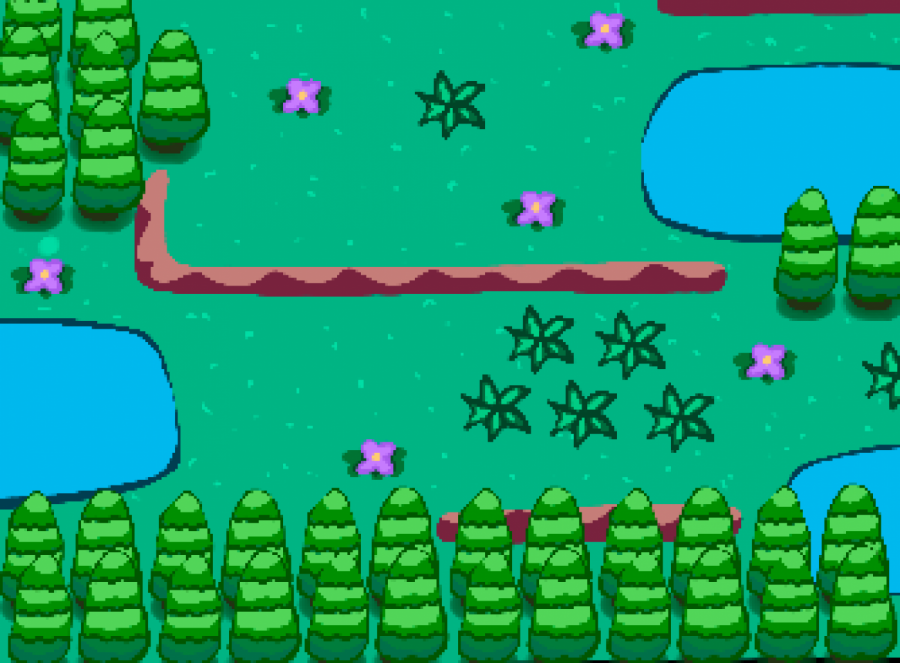An 8-bit classroom? Professors try new methods of virtual engagement
Nov 16, 2020
Catherine Ott, senior in Engineering, sits at her desk working on her project while her professor walks around the classroom checking in with students and answering any questions they may have.
However, like many other things this year, this classroom has moved online into a virtual meeting space that resembles an old 8-bit video game.
“It’s pretty much like you’re in a classroom,” Ott said. “Just you have a little person on a computer.”
Dr. Andre Schleife, professor in Engineering, teaches MSE 404: Laboratory Studies in Materials Science and Engineering MIC/MAC, a project-based course centered around students working individually under the guidance of their instructor.
In past years, the class was held in a computer lab in the basement of Digital Computer Lab. Students were taught new content and then ran simulations on their individual workstations while the professor and TA went around helping students.
Get The Daily Illini in your inbox!
After he learned about gather.town from a College of Engineering Slack message board, Schleife decided to hold the lab over the virtual meeting space. Schleife said he hopes to capture the course’s computer lab-esque environment virtually.
“I thought that this was a cool and kind of fun way of simulating this environment,” Schleife said.
Along with having webcam, voice chat and screen sharing features, gather.town allows users to control a customizable person in a 2D, 8-bit-style virtual environment.
“I was talking to (a friend) about it and he was like ‘I’m so excited to make my person,’” Ott said.
Schleife said that he simply picked one of the pre-made template spaces, modeled after an office and hosted his class there.
“It’s like a nice office environment, that you can walk around,” said Sai Venkata Gayathri Ayyagari, a TA for MSE 404.
After the sudden and tumultuous shift to remote instruction last spring, faculty members have been trying out and adapting new tools and techniques for teaching virtually, sharing their results with each other.
Dr. Jessica Krogstad, professor of Material Science and Engineering, decided to make her asynchronous lectures more interactive last spring, knowing that her students might struggle with listening to a two-hour long recorded lecture.
By interrupting asynchronous lecture videos with “periodic, low-stakes assessments” on PrairieLearn, the platform where her lectures are hosted, Krogstad hoped to “maintain the interactive experience of an iClicker-based lecture.”
“It also gives students an opportunity to pause and think about what I was just lecturing on,” Krogstad said. “So, I wanted to recreate that.”
Krogstad broke up her lecture into shorter videos and added intermittent questions and example problems that students would answer on PrairieLearn.
However, the feedback that Krogstad received was very mixed. Some students enjoyed this format as it allowed them to stop and think, whereas others found it “super annoying.”
“They just wanted to listen to it at twice the speed and this interrupted it,” Krogstad said.
Krogstad hopes to continue using this format next semester after students have spent more time with remote instruction, but also plans on using a combination of asynchronous and synchronous learning.
“We’re trying to be adaptable; we’re trying to continue to learn and make improvements,” Krogstad said.
While experimenting with different techniques for remote instruction, faculty members are also discovering which tools and strategies are better suited for different types of classes. Although Schleife hosts the more independent project-based parts of his class on gather.town, he gives lectures over Zoom, which he believes is better suited for it.
Moreover, because gather.town does not allow for her to talk to everyone at once, Ayyagari said that she still uses Zoom for announcements and more in-depth explanations of concepts to the whole class.
“If there’s something that I have to tell everyone,” Ayyagari said. “I would jump back to Zoom.”
Ott believes that the project-based nature of the course makes gather.town better suited for MSE 404 than Zoom breakout rooms. However, she still prefers Zoom breakout rooms for group work or discussion, because “you kind of have to have a conversation.”
Krogstad, who teaches a smaller course this semester, said that the tools she is currently using would not necessarily be appropriate next spring when she teaches larger classes. Because of her class’s smaller size, Krogstad decided to administer exams orally this semester, where she gauges her students’ understanding one-on-one.
“It’s really just a conversation,” said Krogstad. “But there’s also some give and take; I can provide some guidance when they’re struggling.”
In the coming semester, Krogstad hopes to help with establishing relationships between students, which has been made difficult by the COVID-19 pandemic and the shift to remote instruction.
“Normally, (students) would probably make some really good relationships through study groups and things like that,” Krogstad said. “One of my challenges is finding ways to help the students establish those solid relationships.”
Schleife hopes that students will stay optimistic and strong “until the stupid pandemic is over.”
“I cannot wait to be back in an actual classroom as opposed to the online teaching,” he said.






